#walloon sword
Text
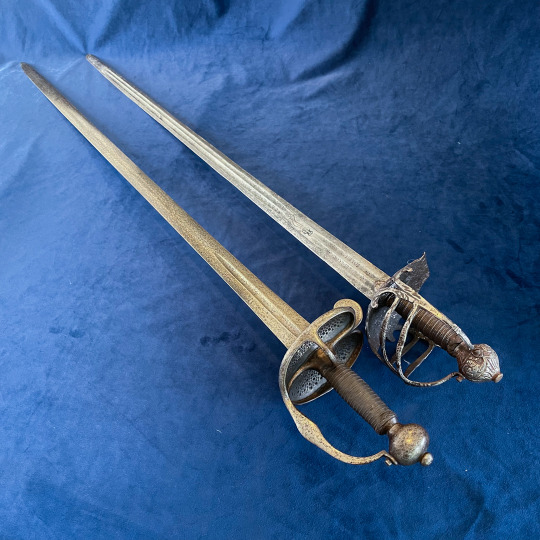


Study of two 17th Century swords; an English ‘mortuary sword’ and a Dutch ‘Walloon’ sword.

The mortuary sword was unique to British Isles and saw extensive use in the English Civil war.
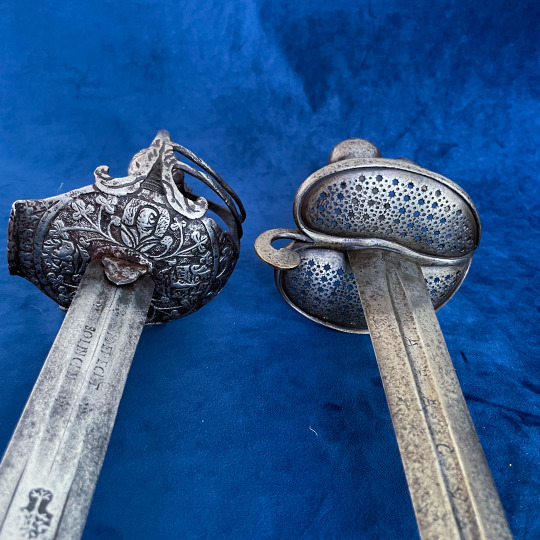

The walloon sword is believed to have originated in Germany and become popular during the 30 Years War that devastated the German States. It is characterised by an asymmetrical disk guard, thumb ring, a knuckle bow and side branches making a rudimentary basket hilt. The shells of the guard are often solid or pierced.


This sword is a later variant of the type and has dispensed with the side branches. The shell guards are separate pieces pressed into the outer rings. The ricasso is stamped with the Amsterdam coat of arms misleading early collectors into believing that they were for the Amsterdam town guard. However considering the number of this exact type survive, too many were made to just supply a city militia.
Current thinking is that the stamp represents a quality control put on the imported blades (Solingen being the most likely source) before local cutlers mounted them with hilts.
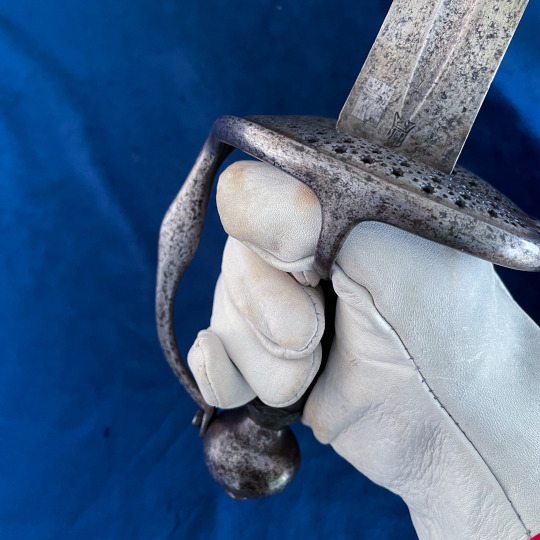
The term ‘walloon sword’ is believed to have come from the French who adopted a sword of this style in the late 17th Century or early 18th Cent. and called it the ‘epee de walloon.’

‘Mortuary sword’ is believed to have been coined in the late 19th Century with the exact reasoning behind the name unknown.
261 notes
·
View notes
Note
Pspspsp, Captain--- Name the top three swords/blades you like to touch your face.

"... Preferably, I would like no swords to touch my face... But if you are asking what my favourite swords are as a choice of weapon? Well... I first favour the Spanish rapier then theres the Mortuary Sword, old fashioned but very brutal hmm and a walloon sword is not too bad...."
1 note
·
View note
Text

So back when I was a kid I I first learned that double-edged broadswords swords with complex hand protection were a thing, I immediately wondered how a sword could be designed to allow both edges of the sword to be used. The resulting idea was a sword with twin knuckle-bows, and I’ve never quite let go of my efforts to design thus on a practical way.
The Original Design was incredibly simple—a broadsword with twin knuckle-guards, and that was all. I like this design only for nostalgic reasons, but still, it has a certain elegant simplicity to it. Kind of gives me a 17th century heavy cavalry vibe. I remember thinking it through and realizing the knuckle bows had to be canted out of the plane of the blade in other to hold it properly, but that was beyond my abilities to create physically as a kid, so when I went to make it out of wood, I ended up with something like a Keyblade guard from Kingdom Hearts (On the plus side, I know for a fact that KH’s Keyblade swords are perfectly serviceable weapons in terms of their hilt design). But I really don’t like it as a practical design anymore. I was in elementary school when I first conceived this design, and thought that a simple knuckle-bow was enough to actual protect your hand (you fool. You absolute buffoon), so there’s really nothing else there to keep those fingers from getting hacked off in a melee. In terms of a serviceable weapon, I wouldn’t choose to wield the Original Design without two considerations: 1) the addition of a thumb ring for a more secure grip and 2) I would only wield it while wearing armored gauntlets.
The Original Design required Modifications in order to create a sword that truly protects one’s hand, so I’ve toyed around with various designs over the years that preserved (or didn’t preserve) the underlying structure of the Original Design. Extra bars, plates, and a cross-guard have all made appearances over the years, but only two design criteria held—there had to be two opposing knuckle bows and the sword had to be able to be “flipped” to make both edges serviceable. As I kept looking up swords online, I began to become better acquainted with 17th-18th century continental European broadswords from the Eighty Years War, Thirty Years War, and the Franco-Dutch wars. Called houwdegen (Dutch, “hewing/cutting/slashing swords”—the Amsterdam Town Guard was armed with a particularly lovely model in the mid-17th century that was copied by the French as their first regulation cavalry sword), haudegen/felddegen (German, “hewing/cutting/slashing swords”/“field swords”), and êpées wallones (French, “Walloon Swords”), these swords were also popular in the British Isles, known in the early 18th century as “sheering/shearing swords” or “spadroons” (Many thanks to Stoccata School of Swordsmanship in Australia for their groundbreaking article on this subject)—a lighter-weight alternative to the British basket-hilted broadsword of Highland Scots fame (a note on terminology: some people say that a “spadroon” is a smallsword with a blade just substantial enough to cut. Those people are wrong. They can fight me What really happened was as the 18th century progressed, the shape of spadroons was simplified and the blade got smaller and narrower until by the Napoleonic Wars it had convergently evolved into a shape reminiscent of the more popular and prestigious Smallsword, but lacking all of its former virtues as a light cutter without being able to effectively match the Smallsword as a light thrusting weapon—the “perfect encumbrance”). My modifications have tended to stick with the early- to mid-17th century cavalry vibes, but eventually I couldn’t deny what this sword wanted to be…
I ended up conceiving a late 17th-century/early 18th century Walloon Sword/Sheering Sword/Spadroon (the time period roughly corresponding to the Golden Age of Piracy). Following the lead of the Amsterdam Town Guard’s model, I gave the sword a bilobate shell guard which does the heavy lifting of protecting the fingers. Most Walloon swords (though not the Amsterdam model) actually have two knuckle-bows—one is a regularly-placed knuckle-bow in the same plane as the cutting edge of the blade, and a second one mounted 90 degrees to the first one. I simply made both of them about 30 degrees off the plane of the blade. I still thought the user’s hand needed extra protection, so I added first one, then two cross-bars spanning the knuckle-bows—again, these bars (usually one) connecting the two knuckle bows are common features of Northern European military swords of the late 17th/early 18th century. The little bit of asymmetry makes it more aesthetically pleasing, in my opinion. The inside shell might be smaller than the outside shell, and may sport or curl into a thumb ring, although that feature is optional. The sword also features a vestigial, decorative cross guard.
One final variant I experimented with was designing a double-knuckle bow Sidesword or War Rapier that might be compatible with my main fencing system—Destreza. Sadly, my personal rapier fencing style would be encumbered by knuckle bows similar to the Original Design, which really force you to adopt a hammer-grip and emphasize heavy downward strokes (that thing really is a cavalry weapon). However, I managed to adapt the design by bending in the knuckle-bows to create a curve where my wrist can fit during some of the actions I prefer to use. The final guard ends up a variant of a two- or three-ring swept hilt (depending on if you consider the adapted knuckle-bows the third ring or not) with wide S-shaped quillons to trap an opponent’s blade and closed front rings to protect the fingers. The inner guard has two rings, braced against the cross-guard. Overall, I’m not terribly satisfied with this design—the double knuckle bow sword was always meant to be primarily a cutting weapon, and it’s design lends itself much more readily to cut-fencing, such as the British broadsword systems, which I’m also studying anyway.
TL;DR I actually redesigned an old childhood weapon into something useable as a fencing weapon. Now, to see if we can bring it to life in synthetics…
#sketch#sword#fantasy sword#broadsword#spadroon#sheering sword#Walloon sword#rapier#sidesword#war rapier#cavalry sword#sword design#original design
8 notes
·
View notes
Text
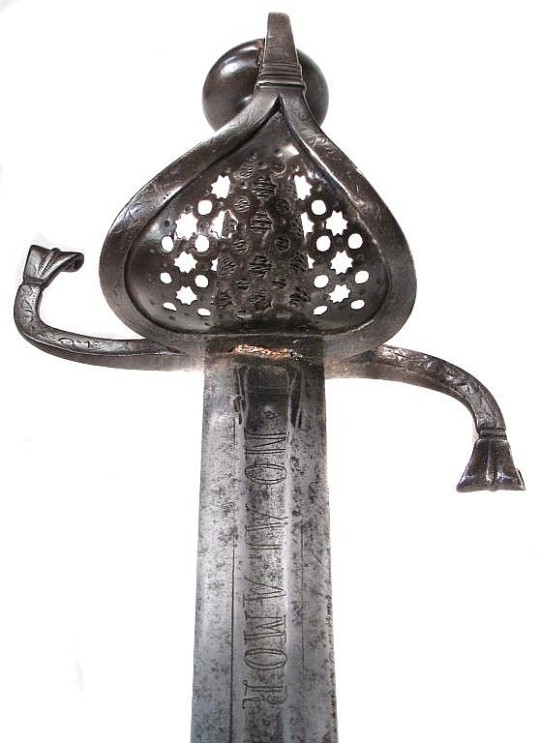

A transitional Walloon style Broadsword,
OaL: 37 in/94 cm
Germany, early 17th century, from Auctions Imperial.
#weapons#sword#broadsword#walloon#europe#european#germany#german#hre#holy roman empire#early modern#auctions imperial#art#history
114 notes
·
View notes
Text
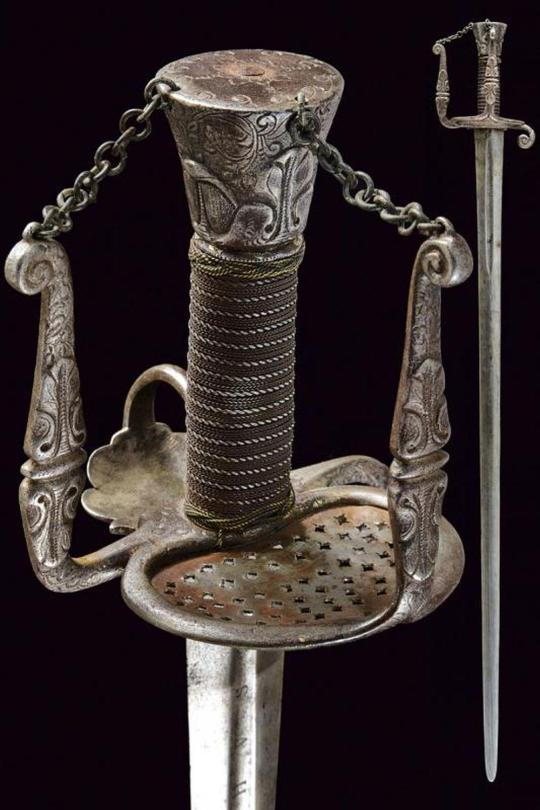
Walloon type sword, Northern Europe, 17th century
from Czerny's International Auction House
199 notes
·
View notes
Note
onee-sama, If you could, will you write about the midcin suitors and their swords, pretty please? :) I've been seeing plenty of amazing weapons on my dash and I thought of you hehe. Stay safe and stay healthy too!
a/n: imouto – you are asking me??? to write about swords?? Ahaha! Ahahahahaahahh – yes
do i love weapons? yes. have i been heavily influenced by growing up and seeing amazing weapons in games and anime? absolutely. did i research this? somewhat. do i have absolutely any idea how to describe swords in a fantastical way? i tried.
any discrepancies as to timeline, i ask you dearest reader to indulge. the term sword is a broad term used to refer to all bladed weapons which are longer than knives. To properly describe a sword, one must look at the historical epoch, the region, and the intended use. Its precise definition thus may appropriately vary.
With all that done, I think we can begin.
Midnight Cinderella Suitors and the Swords they chose (or think they did)
Alyn Crawford has carried many swords to battle, but he favors a double-edged pallasch, grooved and ridged on both faces. It is a practical thing, resilient and heavy in his hands, bare of any decorations save his own Captain’s crest – the snarling mouth of a long-eared dog – carved on the knuckle guard, and twin droplets of rubies at the base of the blade.
Alyn received the sword as a gift from the Wysterian King on the eve of his acceptance into the Royal Guard select. Alyn remembers there had been no moon that night. He does not remember if the King had ever looked so sorrowful.
He carries it with him wherever he goes, sheathed, polished, and sharp, as a knight’s weapon is expected to be, ready to be drawn and used at a moment’s notice. The gleam of the silver blade does not give away its age, how many battles it has triumphed through, how much blood has been cleaned from it.
Alyn has named his sword Excidium, and tries very hard not to roar alongside it during war.
Leo Crawford similarly favors the practical and resilient sword, and carries an estoc. Much like his twin’s, Leo’s sword is bare of any decoration, save for red flames engraved and crisscrossing on the dull grey blade, from base to tip, and the Crawford crest of a bird in flight drawn on the leather wrapped around the hilt.
But unlike his twin, Leo prefers to leave space for some ingenuity. At the center of the blade is a smooth and edgeless portion that allows him to grip the weapon with his other hand to deliver a more powerful blow, or a more poignant point, thrusting and piercing into armor with relative ease and the quiet simmering rage he is careful to never display.
Leo has taken care of this sword since he was twelve. A relic, he would describe it, if he was flustered; a nightmare, if he was about to be damned. He carries it with him when he takes long and winding walks, whenever he visits the Crawford estate, and on days he thinks it would rain.
Leo will never say he has named it Ignis, after the embers stretched out in the sky on the night he had dug it from their parents’ grave. Nor will he ever say that whenever he wields it, he could, ever so faintly, hear their voices whispering to him again.
Louis Howard has never been one to participate in any degree of violence but a Duke must carry a sword, if not for practical purposes then at least, something decorative. It took a long time for Louis to truly choose a sword – until it was too little, too late.
The walloon he carries with him was not chosen so much as the only thing back then nearest to him that he could grip with his one functioning hand, to try to defend the one person he loved the most. And from then on, he had turned to it over and over again.
It is a beautiful thing, with a polished iron guard that had punched holes in the shape of flowers, and a blade the color of the sky that glowed whenever Louis held it, and sang whenever it cut through air. Louis tries not to relish how the sword is like an extension of his arm now, that he has never been seen without it, and that he sometimes stares at it transfixed through the night.
Louis has named his sword Agonist. But Louis really need not struggle, need not resist. He only need carry it with him always – or risk losing a loved one again.
Giles Christophe’s affinity with swords had always been in his blood, in his name, in his soul – so when he had been unceremoniously disinherited by his family without having been bequeathed a weapon, Giles threw everything he had into making his own.
His schiavona is an intricate thing. Forged to be slightly lighter than most to suit his needs, and with a sharper double-edged blade and pointier tip to make up for what he does not have. The guard is a dizzying and complex black metal work in the shape of an unfurled wing, formed by thin strips bending and curving around the hilt and enclosing most of his hand. One might even notice the distinctly shaped cat’s-head pommel – if they were lucky enough to get a close look. But who can really say?
Giles rarely carries his sword with him as his duties as Chamberlain require only his wit as a weapon. Many people are thankful for this, because it never bode well for anyone when Giles appears wielding his stark black blade.
Giles has named his sword Vindicta. He longs for the day when he could finally carry it without shame. He has not had enough of its screaming.
Sid carries a claymore, a daunting thing, with a long, straight, and broad double-edged blade, serrated at the tip, that would have made anyone else look gangly while wielding it. The angled guard made the hilt take the shape of a cross, and it is encrusted with multiple sapphires on both ends which glinted like the All-Seeing Eyes of old.
But do not mention this as Sid has never been one for superstition. The sapphires were there as pawn pieces, he would maintain, not because he they had been the first thing that caught his attention when he won them in a card game, not because he had always been able to predict a blow coming from behind. Not because, and this he would adamantly insist, the Eyes help him see.
Sid never walks the streets without his sword and makes a point to brandish it whenever conducting his business. Sheathed, if he was feeling charitable; through a body part, if not. A dark blue weapon that seemed to coax even the most unwilling tongues to speak.
Sid has named his sword Attestation. It would be best to never ask him why he keeps telling you the sword knows when you lie.
Rayvis Harneit carries a sashka, the curved, narrow blade and guardless hilt an ideal weapon for the streets the Nightwatch patrols. It is a striking thing, the blade unnaturally white like bone, and was carved with fangs on both edges, making it look as if it were serrated. Rayvis is careful not to touch them – too many have bled even when hit with the blunt end.
The scabbard that holds the sword is equally striking, gray painted wood that ended in a wolf’s snarling mouth. It would have been less unnerving if not for the stubborn stains in the shape of a hand around it.
Rayvis carries his sword only during his patrols as it is the last thing he received from his parents before their untimely end. A memento precious and useful. He hopes it would not be the last thing he is holding when he meets his own death.
Rayvis has named his sword Venari. He can feel its hunger grow with every strike.
Byron Wagner’s sword is a katzbalger, with an owl distinctly etched on its pommel. It is a mysterious thing, with a double-edged blade so black it seemed to have been sculpted from ink. It would not have been noticeable in the dark if not for the dozens of tiny gemstones peppered into the blade that sparkled at the barest hint of moonlight. It is no exaggeration to say that whenever Byron took his blade, it looked as if he wielded the night in his hands.
He received the sword from his father the moment he learned to speak. A treasure, surely, and the only gift he had received from the mad king that did not outright give him grief.
Byron carries his sword in the same way as the Steiner kings have done before him: sheathed in an even darker scabbard carved with ancient, looping Steiner symbols for eternal rule; always with him even in his sleep; and held as close as possible to his person, as to replace his heart.
Byron has named his sword Kaalam, and hopes to make a world where he does not always have to turn to it to make people understand.
Albert Burckhardt’s zweihänder is a heavy thing. It stands up to his chin, with a double-edged blade and a large diamond shaped onyx where the hilt began. The hilt, in turn, is cruciform, brown on black and brown, and had just enough space for Albert’s two hands – not that Albert needed both to lift the giant of a sword – but everyone else’s seem to be an ill-fit, their grip not quite right, always slipping, always grasping it wrong, or unable to carry its full weight.
The sword is a family treasure, passed down the Burckhardt line to the child who was to truly serve the Steiner King. Albert remembers his mother had confessed to him that it was not Albert accepting the sword. It was him who was had been accepted. No one else could hold it without cutting themselves on the blade.
Albert carries the sword at his back with a special double leather sheath, its straps running across Albert’s chest to secure the heavy sword behind him. Sometimes, it almost feels as if it were giving him a tender embrace.
Albert has named his sword Ardent, like all the wishes he does not have the courage to say.
Nico Meier does not look as if he knows how to wield a sword, and this grossly inaccurate impression has always worked to his advantage. The rapier he keeps at his hip only added to his veneer as an attendant, looking more decorative than useful. His sword had a golden hilt and a scabbard with gold rings at the bottom, both intricately carved with falling petals. The hand guard, though only two strips of curved metal, was masterfully done and inlaid with small tourmalines.
The rest of the sword was deadly – Nico makes sure of it. He keeps the point finely polished to prick at the slightest touch, and the edges of the slender blade sharp. What looked like a strictly piercing weapon could inflict a thousand cuts. Like its master, it is a misleading thing, and the story of where he came to own it changes every time he tells it.
Nico carries his sword as he would any delicate china, lightly, playfully, and with a certain flair, able to switch from his right to his left and back again with relative ease. The duality is second nature and one must do their best to keep up, or perish.
Nico has named his sword Constante, and ironically is the only true thing he believes in in this world.
Robert Branche would always prefer holding his paintbrushes over a weapon, even to save his own life, but he does own an old schweizersabel, its knuckle guard still intact despite the wars Robert had tried to bury it in.
The sword’s blade is long and curved without compromising its sharp edge. And though it is a slightly dented thing, its re-curved quilliones scratched in every place, it has never lost a speck of its elegance. The green hilt still had its sheen as if in its prime, the knuckle guard still glinted despite several decades of neglect, and at an angle the carved runes on the blade would even seemingly shine, as if holding in some mysterious power, as if proud that despite all of Robert’s efforts, the sword remains by his side. Robert can read them. He will never translate it out loud.
It is hard for Robert to shake off old habits – the sword will never let him – so he continues to carry it wherever he might go, even for running simple errands for his home or his art. His grip would be iron-tight, keeping it firmly in its scabbard. And though it had been lifetimes since he had used it last, he knows he can never be too careful with a sword untouched by time.
Robert has never named his sword. He is afraid of its memories.
#midnight cinderella#was this how you thought i would do it imouto? ahaha#Alyn Crawford#Leo Crawford#Louis Howard#Giles Christophe#Sid#Byron Wagner#Albert Burckhardt#Nico Meier#Rayvis Harneit#Robert Branche#ythmir writes#ythmir fanfics#midcin headcanons#OHBOY IT'S BEEN A WHILE SINCE I WROTE A HEADCANON#i got real rusty so i hope this is something you can enjoy
105 notes
·
View notes
Note
what were british heavy cavalry swords like in early-mid 1700s? my search results are clogged by the 1796. i remember reading somewhere that highland hilts were favored but i would have thought more asymmetric "pallasch" hilts like on the continent would be used. any info would be appreciated. [i know it's not victorian sorry]
@ralph-of-upmeads
You are correct, in the early to mid-18th Century, basket hilts were favored by heavy cavalry in Britain. Below are a few mid-18th century examples from the Royal Armouries online collection. As you can see, the basket hilt designs vary greatly, but they all offer good hand protection.
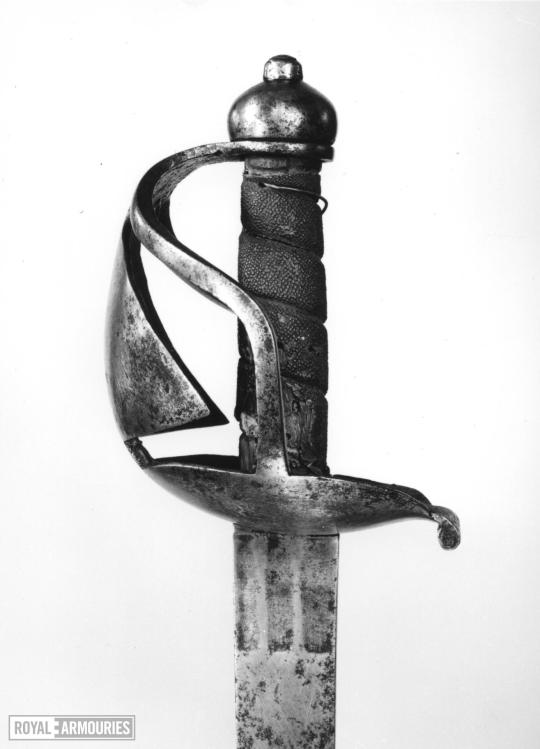



Here is a nice example from the Household Cavalry Museum in London:
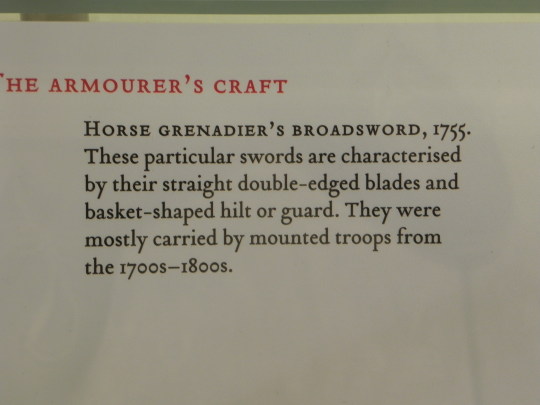
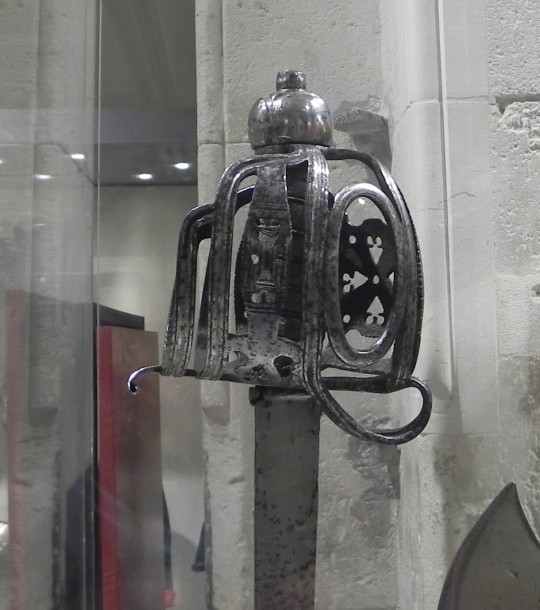

A Walloon style hilt was quite common in Britain in the late 17th Century and early 18th Century.

Here are a few more 17th century swords from the Household Cavalry Museum in London:
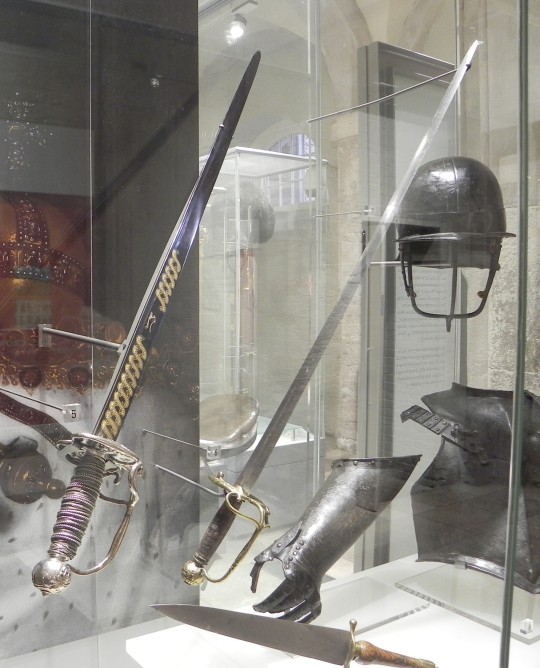


I recommend Swords & Blades of the American Revolution by George C. Neumann for loads of photos of early to mid-18th Century cavalry swords from Britain, America, and various European countries.
30 notes
·
View notes
Text
DEMOLITION HAS BEGUN!!! 해외안전놀이터추천 HOTEL BATHROOMS HER WE COME!!!
Deck celebrating the union of Brittany and France with Spanish suits but has queens instead of knights Antoine de Logiriera of Toulouse, c.1500. To win the jackpot, you’ll need to get dealt a royal flush in any suit. Should you be so lucky, you’ll immediately win 100% of the jackpot. If you get a straight flush, you’ll get 10% of the jackpot. Belgian decks come in either 32 or 52 cards like in France. A player may wish to make multiple different bets. For example, a player may be wish to bet $1 on all hard ways and the horn. If one of the bets win the dealer may automatically replenish the losing bet with profits from the winning bet.
Lowe took the game to New York where friends liked playing it. http://query.nytimes.com/search/sitesearch/?action=click&contentCollection®ion=TopBar&WT.nav=searchWidget&module=SearchSubmit&pgtype=Homepage#/메이저공원 However, it runs into problems when it tries to spot patterns in games that are random. Some games require only one number to be matched, while cover-all games award the jackpot for covering an entire card. Always fold with less than an Ace-King. If you hold an Ace-Queen, fold the hand.Do not hesitate to fold with an A-Q or worse. This is less than the dealer’s minimum qualifying hand, so it’s a sure loser.Also fold when you hold an Ace-King and none of the 3 scenarios in Tip #1 are given.
For example, if a player says "hop the tens" (6–4, 5–5, 4–6) the player must give the dealer an even number bet so it can be divided among the hard and easy ways. They are also commonly found in France's former colonies. Within Belgium, the Francophone Walloons are the primary users of this pattern, the Flemish prefer the Dutch pattern. this is the second most common pattern in the world after the English pattern. There is a legal precedent in Atlantic City that keeps you safe in a casino when card counting. A card came guide named Yezi Gex, attributed to a Tang female writer, has also been cited by some Chinese scholars of subsequent dynasties.

A second card face down to the dealer to the right of the dealer’s first card dealt face up;and A third, fourth and fifth card face down to each player and the dealer, in succession,directly on top of the preceding card dealt face down. In terms of total turnover, lotteries are the leading form of gambling worldwide. The popular casino game has been featured in many films and TV shows across the world.Also typically at this level of play (house rules allowing) the experienced croupier caters to the needs of the customer and will most often add the customer's winning bet to the payout, as the type of player playing these bets very rarely bets the same number two spins in succession.
The word spade probably represents the Old Spanish spado (“sword”), while club is a direct translation of basto, implying that Spanish suits were used… If the casino allows a maximum bet of $1,000 on a 35-to-1 straight-up, then on each 17-to-1 split connected to that straight-up, $2,000 may be wagered. Each 8-to-1 corner that covers four numbers) may have $4,000 wagered on it. Until the 1980s, pachinko machines were mechanical devices,[10] using bells to indicate different states of the machine. Electricity was used only to flash lights and to indicate problems, such as a machine emptied of its balls.Come bets can only be made after a point has been established since, on the come-out roll, a Come bet would be the same thing as a pass line bet.
This terrifies casino operators, as it is difficult and expensive to recover from perceptions of a high-priced slot product. But you need to bring more than that with you. You need enough of a cushion to ride out the inevitable losing streaks that happen in any game. Some casinos also offer split-final bets, for example final 5-8 would be a 4-chip bet, one chip each on the splits 5-8, 15-18, 25-28, and one on 35.In reality, he simply observed more than 10,000 spins of each roulette wheel to determine flaws in the wheels.
Of course, the first outcome is far more common than the other two – it has to be for the casino to maintain its house advantage. Movies like Rain Man and 21 make card counting seem like wizardry, but it's actually fairly simple arithmetic. The house edge or vigorish is defined as the casino profit expressed as the percentage of the player's original bet. (In games such as blackjack or Spanish 21, the final bet may be several times the original bet, if the player double and splits.)This means that he has to count cards.
But remember not to feel pressured just because someone in the group is spending more or playing longer. Know your own limits. The game was further popularized by Edwin Lowe. While at a traveling carnival near Atlanta in December 1929 the toy merchandiser saw people eagerly playing a game called "Beano" following Ward's rules, with dried beans, a rubber stamp, and cardboard sheets. The Founder of FedEx Frederick Smith has to gamble to save his company.안전한놀이터주소The suburb of Buffalo's large Polish-American Catholic population is believed to be a factor for bingo's outsized popularity in Western New York, which has five times as many bingo halls per capita as the rest of the state.
0 notes
Text
Why The Trump Taj Mahal 먹튀검증업체 Failed #489
The place bets on the 6 & 8 should be made in units of $6, (on a $5 minimum table), in order to receive the correct exact payout of $6 paying $7. For the 4 and 10, it is to the player's advantage to 'buy' the bet (see below). This is a fast-paced and exciting form of bingo typically played in fraternal organizations. A large number of games are based around a deck in which each card has a value and a suit (usually represented by a color), and for each suit there is exactly one card having each value, though in many cases the deck has various special cards as well. Examples include Mü und Mehr, Lost Cities, DUO, Sticheln, Rage, Schotten Totten, UNO, Oh-No!, Skip-Bo, and Rook. Then, in 2014, GLI analyzed the current rules you see below. They developed an unpublished strategy to the game and then ran it through a simulation.
The English pattern, based on the Rouennais pattern, is the most well known pattern in the world. http://query.nytimes.com/search/sitesearch/?action=click&contentCollection®ion=TopBar&WT.nav=searchWidget&module=SearchSubmit&pgtype=Homepage#/메이저놀이터리스트 Unlike come bets, the odds laid behind points established by don't come bets are always working including come out rolls unless the player specifies otherwise. A come-out roll of 2, 3 or 12 is called "craps" or "crapping out", and anyone betting the Pass line loses. The player's one-unit bet stays on the table until the outcome is determined.
Some may also discourage or disallow unsanitary practices such as kissing or spitting on the dice. Some casinos also took the initiative of changing rules to make the game harder to play and win. The dealer's decisions, then, are automatic on all plays, whereas the player always has the option of taking one or more cards. Following the inspection of the cards by the dealer and the verification by the floorperson assigned to the table, the cards shall be spread out face up on the table for visual inspection by the first player to arrive at the table.
A number may be backed along with the two numbers on the either side of it in a 5-chip bet. Other suits exist and are called standard patterns. For example, modern Italian card decks have four suits—cups, coins, swords, and clubs (or batons). They are also commonly found in France's former colonies. Within Belgium, the Francophone Walloons are the primary users of this pattern, the Flemish prefer the Dutch pattern. this is the second most common pattern in the world after the English pattern.Symbolism of Popular legend holds that the composition of a deck of cards has religious, mystical, or astrological significance.
The Livery Company still exists, and, despite the almost total cessation of production of playing-cards in Britain, flourishes. In 1994 it achieved its highest ambition in the City of London, when a former Master of the Company, Alderman Christopher Walford, became Lord Mayor. The sum of all the numbers on the roulette wheel (from 0 to 36) is 666, which is the "Number of the Beast". Monte Carlo Casino has been depicted in many books, including Ben Mezrich's Busting Vegas, where a group of Massachusetts Institute of Technology students beat the casino out of nearly $1 million. This book is based on real people and events; however, many of those events are contested by main character Semyon Dukach.[18] Monte Carlo Casino has also been featured in multiple James Bond novels and films.The contemporary casino business is a unique industry that is concentrated in Las Vegas and Macau.

When the dealer has served every player, the dealers face-down card is turned up. Blackjack is the only game offered by casinos, where it is proven that players can beat the dealer on the long term. Probability statements apply in practice to a long series of events but not to individual ones. 퍼스트카지노 Gaming machines are by far the most popular type of casino activity.
Lay bet maximum are equal to the table maximum win, so if a player wishes to lay the 4 or 10, he or she may bet twice at amount of the table maximum for the win to be table maximum. And the majority of Blackjack gamblers make the wrong decisions over and over again. A player making $10 bets on a single number (with only 1/38 chance of success) with a $100 bankroll is far more likely to lose all of his money after only 10 bets.Like single-roll bets, hard way bets can be lower than the table minimum; however, the maximum bet allowed is also lower than the table maximum.
Do residents from Macau and Singapore have diverse viewpoints in relation to possible correlations between gambling behaviors and attitudes and the impacts of casino gambling operations? This adds excitement to playing as any given machine will have several common patterns or animations that can occur, with some having much more significance than others in terms of ultimate odds of winning on a given spin. When the card is inserted into a reader at a slot or video poker machine, a display on the reader might say something like, "Welcome, member.The 1866 novella, titled The Gambler, by the famous Russian writer Fyodor Dostoyevsky has a prime focus of the game as a major theme throughout the story.
0 notes
Text


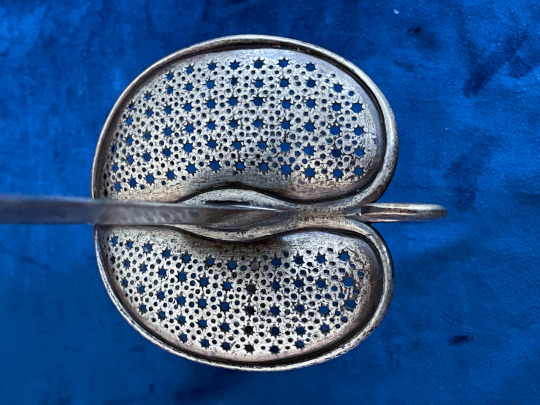

17th Century 'Walloon' Sword.
While I've shown this sword before, I've held back from making a dedicated post while I attempted to researched it further. Unfortunately, there just isn't enough information available to come to any definitive conclusions and we are left to speculate based on snippets of information and clues we find in the objects themselves.
This style of sword is typically described and the 'Amsterdam town guard sword.' And is a sub-class of the broader 'Walloon' sword.
Calling these 'Walloon swords' is another modern collectors' practice of convenience which is believed to have originated with the French cavalry sword; 'Epee Wallone' which was in service from the late 17th to the middle of the 18th Century.
Walloon swords are believed to have originated in the German states of the Holy Roman Empire during the time of the Thirty Years War. They are identified by the asymmetrical disk shaped guards, solid knuckle guard with two of more side branches. The guards can be solid and decorated with grotesque faces, animals or plant motifs, or they can be perforated. Typically they will have a thumb-ring attached on the left underside of the guard. Blades can be either double or single edged.
The 'Amsterdam' Walloon sword, named because of the Amsterdam Coat of Arms invariably found stamped into the ricasso, is a very distinct sub-type that features a perforated asymmetrical disk guard decorated with pierced suns surrounded by moons. It is finished by a short upturned rear quillon. They have a single knuckle bow which is fixed to the ball pommel by a screw and a thumb-ring on the left side that extends out to the edge of the guard. The grip is wrapped with wire and finished at both ends with a 'Turks head' knot. The blades are long, double edged with a single fuller at the base. They are invariably stamped with triple Xs under a crown Coat of Arms for Amsterdam. The surviving examples are very uniform for this period in time, making it is possible that this was the first European pattern sword produced.
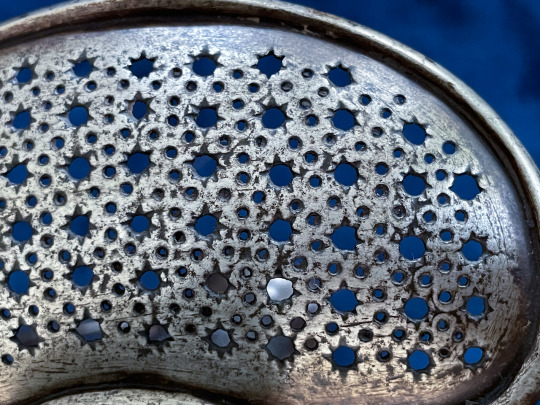

While the link to Amsterdam is clear in the markings, it is unlikely that this type of sword was issued to the cities guard or militia. The number of surviving examples indicate that these were made in too large quantities to have been issued to a small localised force.
During the 17th Century, The Netherlands was a republic of seven provinces. And rather than a standing national army, each province would have supplied and maintained their own levies in times of war. One possibility is that these swords were supplied to the cavalry of the Province of Holland, of which Amsterdam was the economic capital.
Another theory is that the French experience of 'Walloon' swords, encountered during their war with the Dutch in 1672 to 1673. Dissatisfied with their current cavalry swords, French King Louis XIV ordered that his cavalry be equipped with a new sword of the 'Walloon' type. This is discussed in an article in the French magazine Gazette des Armes.
However that doesn't explain the presence of the Amsterdam Coat of Arms on these swords. Then again, Amsterdam was a major mercantile center for Europe, and it is possible that the French order was brokered by Dutch merchants who placed their mark on the blades when they arrived from Solingen.
It should also be noted that the Amsterdam mark is often accompanied by the Solingen blade smiths' own mark. On this sword the makers mark is mostly obscured by the guard, but you can just make out the top of a crown at the ricasso (the horizontal stamp is another verson of the Dutch markings).
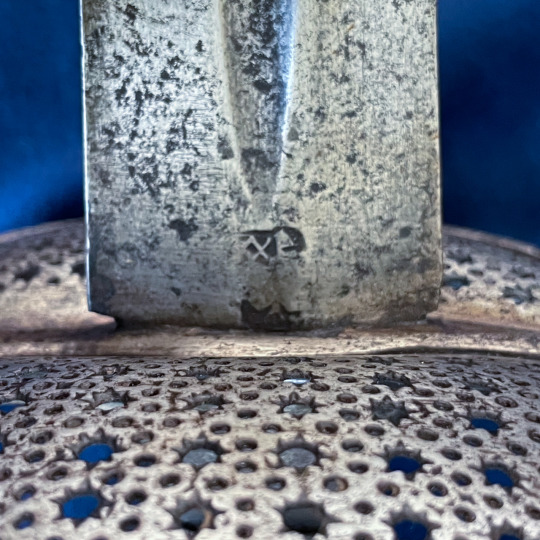
In the hand, this is a beast of a sword, the grip and guard are large to accommodate gloves and the blade is very long, suitable for fighting from horseback. But despite its' proportions, it is not a heavy or unwieldy sword.
Stats:
Overall Length - 1,080 mm
Blade Length - 920 mm
Point of Balance - 120 mm
Grip Length - 145 mm
Inside Grip Length - 120 mm
Weight - 990 grams
181 notes
·
View notes
Photo
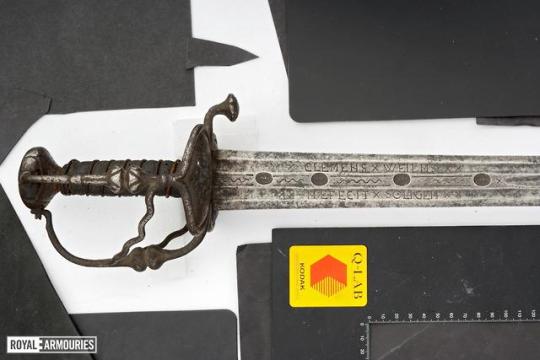

A fantastic Walloon style Broadsword, attributed to Klemenz Willens, Solingen, Germany, ca. 1671-1699, housed at the Royal Armouries Study Collection.
#weapons#sword#broadsword#walloon#europe#european#germany#german#solingen#hre#holy roman empire#renaissance#early modern#royal armouries#study collection#art#history
195 notes
·
View notes
Text
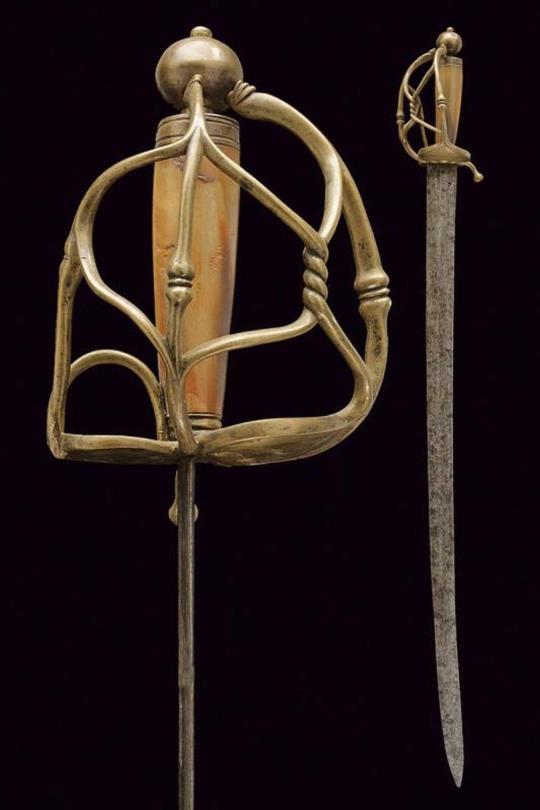
Walloon type sword, Northern Germany, 17th century
from Czerny's International Auction House
108 notes
·
View notes
Text
Guinea’s President Alpha Condé hints that he may scrap term limits

THE main road from the Sierra Leone border to Guinea’s capital is lined with more than just potholes. Armed men sit in the shade at makeshift checkpoints and take turns to extort money from passers-by. Despite all the correct paperwork, your correspondent was robbed eight times in under an hour. “Your bag looks suspicious,” said one guard, clasping his Kalashnikov. It was just a bag full of dirty laundry, but the guard shook his head. Clearly stinky socks were a threat to national security. Fortunately, he had a solution. “Give me 40,000 francs ($4.50),” he said.
Despite appearances, Guinea has grown less corrupt under Alpha Condé, who has been president since 2010. In the year he was elected the country ranked a woeful 164th out of 178 countries on an index of corruption compiled by Transparency International, a watchdog. Now high-level graft has ebbed a bit. By 2017 Guinea had moved up to 148th, grabby border police notwithstanding.
Get our daily newsletter
Upgrade your inbox and get our Daily Dispatch and Editor's Picks.
Cleaning up has not been easy. A graft-busting treasury chief was assassinated by men in military uniform in 2012. And activists complain that high-ranking officials are never prosecuted for taking backhanders. “The only people [in prisons] have stolen chickens,” says Frédéric Loua, founder of Same Rights for All, a human-rights group.
Surrounded by ornate swords in his palace, Mr Condé says his country is a better place. The former dissident and political prisoner has a point. Guinea’s previous leaders were a brutal bunch. They included Ahmed Sékou Touré, a deranged despot who ruled for 26 years, and a string of grotesquely corrupt military juntas whose soldiers raped and massacred opposition supporters. Civilian rule under Mr Condé has been more peaceful.
Economic growth is picking up, too. It hit 6.7% last year, helped by a boom in mining as well as the government’s genuine efforts to attract investment. Even so, despite vast mineral wealth, Guinea is desperately poor, with a GDP of little more than $800 per person, about half the region’s average.
People are losing patience. Thousands have taken to the streets to complain about poor pay, a lack of electricity, police brutality and allegations of voter fraud in the recent local elections. At least 15 people have died in clashes in the past two months.
Given Guinea’s ethnic tensions, this is ominous. The president’s party, the Rally of the Guinean People (RPG), is dominated by the Malinké group, who are about 35% of the population. The largest opposition party, the Union of Democratic Forces of Guinea (UFDG), mainly come from the Peul group, roughly 40% of the country. Many Peul feel they have been discriminated against by the Condé government. The UFDG says that dozens of Peul have been killed by the security forces. Instead of calming tensions, some politicians are encouraging their supporters to “break the mouths” of the opposition.
Mr Condé dismisses such concerns: “Flemings and Walloons in Belgium...find it hard to live together but nobody talks about it. They talk about ethnicity only for Africa.” Some worry that Mr Condé will try to change the constitution so that he can run for a third term in 2020. That would surely provoke violence in the street. Yet Mr Condé refuses to scotch the rumour. It is “the Guinean population’s decision, not mine”, he tells The Economist. He also argues that African presidents should not have term limits, because these get in the way of them carrying out ambitious long-term projects. Ordinary Africans have heard this line before.
Outside the palace, a car trundles past with loudspeakers singing presidential praise. “Alpha Condé is the father of the nation. Alpha Condé is the husband to all the women.” Mr Condé has indeed moved the country on from its dark days. But he should know when to let go.
This article appeared in the Middle East and Africa section of the print edition under the headline "Alpha’s bet"
https://ift.tt/2HxQizu
0 notes
Text
The Spadroon is Not a Militarized Smallsword
“Spadroon is a militarised smallsword” – This is a statement I hear a lot, and one I would like to see an end to. Not because the smallsword is a bad weapon, but because that statement undermines what the spadroon is and how it developed. The implication is that gentlemen in the late 18th century started adopting a slightly beefy smallsword to utilize their existing smallsword/foil skills. But this ignores the fact that spadroons were not new, they were not all for gentlemen, and that the development of smallswords and spadroons was a parallel one.
The spadroon was not based on the smallsword, they were both creations of a trend towards double shell simpler hilted swords that emphasized the point and were easy to wear/carry. This development really began in the early 17th century, and in some cases a little earlier in the late 16th. The smallsword is often said to have evolved out of the rapier, and so did the spadroon from military swords of the period. The mortuary, walloon and other munitions grade military swords of the 17th century spreading approx. 1630-1680. These were not even exclusively ”gentlemans” swords, but general use military swords.
Additionally, the “Spadroon is a militarised smallsword” statement dismisses it’s cutting ability as a throw away feature. Assuming it is merely beefed up smallsword for war that still can’t really cut. Yet that is far from true. The spadroon is a cut and thrust sword just as most 19th century sabres were intended to be. Are there bad examples? Sure, but don’t judge an entire category of swords by those bad examples. Don’t even judge the infamous 1796 spadroon by the bad examples, as there is incredible variety to be found. Blades found on the 1796 can be anything from as light as a smallsword to as beefy as some 17th century backswords. All the while still being a spadroon. I am not including the really beefy broadsword bladed 1796s. Even the double shell guards of the 1796 get criticized because they are a copy of the smallsword and not suited to cut and thrust, and yet this ignores the fact that double shell guatds were really popular on military cut and thrust swords for approximately 200 years, for hangers, cutlass, spadroons and broadswords.
The spadroon often looks similar to a smallsword at a casual glance, but that is because of simultaneous development. The spadroon was not a short-lived fad or experiment. Its service was as long as the smallsword, and in some cases longer still. Time to separate these weapons and appreciate them both for what they were and their long and colourful histories.
--Nick Thomas, Academy of Historical Fencing
I agree with Nick, and would also add that many spadroon hilts do not bear any resemblance to smallsword hilts. “Spadroon” really describes a blade type (straight cut and thrust blade) more than an overall sword type (blade and hilt). Spadroons can have just about any hilt type that was to be found in the 17th-19th Centuries. A while back Nick made a nice graphic showing various spadroon hilts over time. Click here for a larger version.
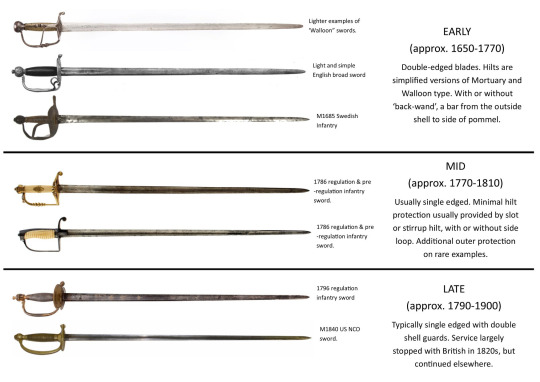
#sword#swords#spadroon#spadroons#smallsword#small-sword#small sword#nick thomas#academy of historical fencing
86 notes
·
View notes
Text
NAFTA drama earns Chrystia Freeland CP’s Business Newsmaker of 2018
OTTAWA — There will be drama.
Foreign Affairs Minister Chrystia Freeland took pains to predict that in a lengthy August 2017 speech that spelled out Canada’s goals at the start of the North American Free Trade Agreement talks with Mexico and the volatile Trump administration.
“I chose my words really carefully because you didn’t have to be a rocket scientist to anticipate that there would be moments of drama,” Freeland recalled in an interview.
“We knew there would be moments where we had to fasten our seatbelts, and I think what was important was to be mentally prepared for those moments, and not to be knocked off course by them.”
Ultimately, Canada’s foreign minister led the country’s efforts to salvage a new North American free trade deal. That white-knuckle ride earned Freeland the title of Canada’s Business Newsmaker of the Year for 2018.
She was the runaway choice of 81 per cent of editors surveyed by The Canadian Press. Alberta Premier Rachel Notley was second with nearly 10 per cent.
Jeff Labow, an editor with the Globe and Mail’s Report on Business, said Freeland “undoubtedly kept her cool amid all the Trump tweeting, lying, changing his direction and ended up with a deal that can be lived with.”
Hugo Fontaine, business editor of La Presse, said Freeland was the “face and the voice” of the Canadian negotiating team.
Freeland led a spasmodic negotiation that was coloured by the personal insults U.S. President Donald Trump hurled at Prime Minister Justin Trudeau and, ultimately, at her. But Freeland said she was never shaken from her “core conviction” — “what I truly felt from the minute that the president was elected” — that a deal on NAFTA was possible.
“One of our colleagues said to me that somehow I seemed always to be a little bit serene. I wouldn’t say I was serene, but I was always confident.”
Freeland was blindsided when Mexico and the U.S. reached a side deal in August, threatening to sideline Canada unless it joined by the end of September. Freeland cut short a three-country European trip and diverted to Washington where she would spend the better part of the next month on the turf of her American counterpart, United States Trade Representative Robert Lighthizer.
Trump had already injected an unprecedented level of drama into the talks. There was his ever-present threat to rip up NAFTA, his post-G7 insults calling Trudeau “very dishonest and weak,” his frequent broadsides against Canadian farmers and supply management. He imposed punishing tariffs on Canadian and Mexican steel and aluminum and swung a Sword of Damocles threatening to add a 25 per cent tax on all Canadian autos entering the U.S.
In late September, days before the U.S.-imposed deadline, Trump told a freewheeling news conference that he was “very unhappy with the negotiations and the negotiating style of Canada. We don’t like their representative very much.”
Prime Minister Justin Trudeau said he wasn’t surprised to hear complaints about Canada’s negotiating team, led by Freeland.
“When you’re in a tough negotiation and the other guy complains about the quality of your negotiators, or how tough your negotiators are, that’s not a reason you should be changing your negotiator,” the prime minister said in an interview.
“That’s a reason to buy your negotiator a beer at the end of the day.”
At the time, Freeland held her powder.
Looking back, Freeland said she laid down some markers for herself, and for Canada, early on. She began making preparations for NAFTA as soon as Trump was elected — two months before her promotion from the trade minister’s job to a retooled foreign affairs portfolio that put her in charge of Canada-U.S. trade.
Trump may have had the Art of the Deal, but Freeland had Steve Verheul, Canada’s chief negotiator. Freeland and Verheul played hardball together to nail down the final version of the Canada-EU trade deal in late 2016, travelling to the nether regions of Belgium to stare down a restive constituency known as the Walloons, who were threatening to veto seven years of negotiations with a Byzantine set of constitutional powers.
Heading into NAFTA, Verheul told Freeland they had to remember an important lesson they had learned. “The worst thing in a trade negotiation is to have a weak or uncertain counterparty because then you can’t get a deal,” the minister recalled. “What you actually really want at the other side of the table is someone who is really smart. Because then, at the end of the day, they will be able, together with you, to identify that win-win landing zone.”
Freeland calls herself an “economic determinist.” That boils down to: “if something makes economic sense, it tends to happen.”
So Freeland kept her focus on Lighthizer. The strapping septuagenarian may share Trump’s protectionist ideology, but he was divorced from the drama of his president’s bluster.
“Bob, at the end of the day if you made a logical case to him, a logical case about why something was in his interest to agree to, he would understand that.”
To this day, Freeland said there are things that she and Lighthizer still disagree on.
“But he is a real pro and it became clear to me, I would say pretty early on, that notwithstanding the very great, great differences in our starting positions that he was a guy we would ultimately be able to do a deal with.”
Late in the evening of Sept. 30, as Freeland was with the team assembled in Trudeau’s office across from Parliament Hill, Canada and the United States ended the suspense and announced their 11th hour deal.
Exactly two months later, Freeland was at the G20 summit in Argentina. She and Lighthizer, along with their Mexican counterpart, Ildefonso Guajardo, stood behind the three North American leaders as the new trade pact was formally signed.
Trump reached out to shake Freeland’s hand.
“He made a point of that, after the signing. I was always very clear that there would be moments of drama,” Freeland recalled.
That was all well and good, but she reminded herself of yet another cold, hard fact.
“I am paid in Canadian dollars. I work for the people of Canada. And the people whose interests I try, heart and soul to earn, are Canadians’, and it is their judgement to which I answer,” she said.
“That’s the judgement that matters to me.”
NAFTA drama earns Chrystia Freeland CP’s Business Newsmaker of 2018 published first on https://worldwideinvestforum.tumblr.com/
0 notes
Text
NAFTA drama earns Chrystia Freeland CP’s Business Newsmaker of 2018
OTTAWA — There will be drama.
Foreign Affairs Minister Chrystia Freeland took pains to predict that in a lengthy August 2017 speech that spelled out Canada’s goals at the start of the North American Free Trade Agreement talks with Mexico and the volatile Trump administration.
“I chose my words really carefully because you didn’t have to be a rocket scientist to anticipate that there would be moments of drama,” Freeland recalled in an interview.
“We knew there would be moments where we had to fasten our seatbelts, and I think what was important was to be mentally prepared for those moments, and not to be knocked off course by them.”
Ultimately, Canada’s foreign minister led the country’s efforts to salvage a new North American free trade deal. That white-knuckle ride earned Freeland the title of Canada’s Business Newsmaker of the Year for 2018.
She was the runaway choice of 81 per cent of editors surveyed by The Canadian Press. Alberta Premier Rachel Notley was second with nearly 10 per cent.
Jeff Labow, an editor with the Globe and Mail’s Report on Business, said Freeland “undoubtedly kept her cool amid all the Trump tweeting, lying, changing his direction and ended up with a deal that can be lived with.”
Hugo Fontaine, business editor of La Presse, said Freeland was the “face and the voice” of the Canadian negotiating team.
Freeland led a spasmodic negotiation that was coloured by the personal insults U.S. President Donald Trump hurled at Prime Minister Justin Trudeau and, ultimately, at her. But Freeland said she was never shaken from her “core conviction” — “what I truly felt from the minute that the president was elected” — that a deal on NAFTA was possible.
“One of our colleagues said to me that somehow I seemed always to be a little bit serene. I wouldn’t say I was serene, but I was always confident.”
Freeland was blindsided when Mexico and the U.S. reached a side deal in August, threatening to sideline Canada unless it joined by the end of September. Freeland cut short a three-country European trip and diverted to Washington where she would spend the better part of the next month on the turf of her American counterpart, United States Trade Representative Robert Lighthizer.
Trump had already injected an unprecedented level of drama into the talks. There was his ever-present threat to rip up NAFTA, his post-G7 insults calling Trudeau “very dishonest and weak,” his frequent broadsides against Canadian farmers and supply management. He imposed punishing tariffs on Canadian and Mexican steel and aluminum and swung a Sword of Damocles threatening to add a 25 per cent tax on all Canadian autos entering the U.S.
In late September, days before the U.S.-imposed deadline, Trump told a freewheeling news conference that he was “very unhappy with the negotiations and the negotiating style of Canada. We don’t like their representative very much.”
Prime Minister Justin Trudeau said he wasn’t surprised to hear complaints about Canada’s negotiating team, led by Freeland.
“When you’re in a tough negotiation and the other guy complains about the quality of your negotiators, or how tough your negotiators are, that’s not a reason you should be changing your negotiator,” the prime minister said in an interview.
“That’s a reason to buy your negotiator a beer at the end of the day.”
At the time, Freeland held her powder.
Looking back, Freeland said she laid down some markers for herself, and for Canada, early on. She began making preparations for NAFTA as soon as Trump was elected — two months before her promotion from the trade minister’s job to a retooled foreign affairs portfolio that put her in charge of Canada-U.S. trade.
Trump may have had the Art of the Deal, but Freeland had Steve Verheul, Canada’s chief negotiator. Freeland and Verheul played hardball together to nail down the final version of the Canada-EU trade deal in late 2016, travelling to the nether regions of Belgium to stare down a restive constituency known as the Walloons, who were threatening to veto seven years of negotiations with a Byzantine set of constitutional powers.
Heading into NAFTA, Verheul told Freeland they had to remember an important lesson they had learned. “The worst thing in a trade negotiation is to have a weak or uncertain counterparty because then you can’t get a deal,” the minister recalled. “What you actually really want at the other side of the table is someone who is really smart. Because then, at the end of the day, they will be able, together with you, to identify that win-win landing zone.”
Freeland calls herself an “economic determinist.” That boils down to: “if something makes economic sense, it tends to happen.”
So Freeland kept her focus on Lighthizer. The strapping septuagenarian may share Trump’s protectionist ideology, but he was divorced from the drama of his president’s bluster.
“Bob, at the end of the day if you made a logical case to him, a logical case about why something was in his interest to agree to, he would understand that.”
To this day, Freeland said there are things that she and Lighthizer still disagree on.
“But he is a real pro and it became clear to me, I would say pretty early on, that notwithstanding the very great, great differences in our starting positions that he was a guy we would ultimately be able to do a deal with.”
Late in the evening of Sept. 30, as Freeland was with the team assembled in Trudeau’s office across from Parliament Hill, Canada and the United States ended the suspense and announced their 11th hour deal.
Exactly two months later, Freeland was at the G20 summit in Argentina. She and Lighthizer, along with their Mexican counterpart, Ildefonso Guajardo, stood behind the three North American leaders as the new trade pact was formally signed.
Trump reached out to shake Freeland’s hand.
“He made a point of that, after the signing. I was always very clear that there would be moments of drama,” Freeland recalled.
That was all well and good, but she reminded herself of yet another cold, hard fact.
“I am paid in Canadian dollars. I work for the people of Canada. And the people whose interests I try, heart and soul to earn, are Canadians’, and it is their judgement to which I answer,” she said.
“That’s the judgement that matters to me.”
from Financial Post https://ift.tt/2RbvmGG
via IFTTT Blogger Mortgage
Tumblr Mortgage
Evernote Mortgage
Wordpress Mortgage
href="https://www.diigo.com/user/gelsi11">Diigo Mortgage
0 notes